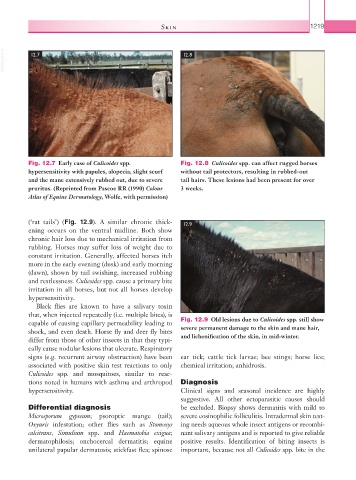Page 1244 - Equine Clinical Medicine, Surgery and Reproduction, 2nd Edition
P. 1244
Skin 1219
VetBooks.ir 12.7 12.8
Fig. 12.7 Early case of Culicoides spp. Fig. 12.8 Culicoides spp. can affect rugged horses
hypersensitivity with papules, alopecia, slight scurf without tail protectors, resulting in rubbed-out
and the mane extensively rubbed out, due to severe tail hairs. These lesions had been present for over
pruritus. (Reprinted from Pascoe RR (1990) Colour 3 weeks.
Atlas of Equine Dermatology, Wolfe, with permission)
(‘rat tails’) (Fig. 12.9). A similar chronic thick- 12.9
ening occurs on the ventral midline. Both show
chronic hair loss due to mechanical irritation from
rubbing. Horses may suffer loss of weight due to
constant irritation. Generally, affected horses itch
more in the early evening (dusk) and early morning
(dawn), shown by tail swishing, increased rubbing
and restlessness. Culicoides spp. cause a primary bite
irritation in all horses, but not all horses develop
hypersensitivity.
Black flies are known to have a salivary toxin
that, when injected repeatedly (i.e. multiple bites), is
capable of causing capillary permeability leading to Fig. 12.9 Old lesions due to Culicoides spp. still show
shock, and even death. Horse fly and deer fly bites severe permanent damage to the skin and mane hair,
differ from those of other insects in that they typi- and lichenification of the skin, in mid-winter.
cally cause nodular lesions that ulcerate. Respiratory
signs (e.g. recurrent airway obstruction) have been ear tick; cattle tick larvae; bee stings; horse lice;
associated with positive skin test reactions to only chemical irritation; anhidrosis.
Culicoides spp. and mosquitoes, similar to reac-
tions noted in humans with asthma and arthropod Diagnosis
hypersensitivity. Clinical signs and seasonal incidence are highly
suggestive. All other ectoparasitic causes should
Differential diagnosis be excluded. Biopsy shows dermatitis with mild to
Microsporum gypseum; psoroptic mange (tail); severe eosinophilic folliculitis. Intradermal skin test-
Oxyuris infestation; other flies such as Stomoxys ing needs aqueous whole insect antigens or recombi-
calcitrans, Simulium spp. and Haematobia exigua; nant salivary antigens and is reported to give reliable
dermatophilosis; onchocercal dermatitis; equine positive results. Identification of biting insects is
unilateral papular dermatosis; stickfast flea; spinose important, because not all Culicoides spp. bite in the

